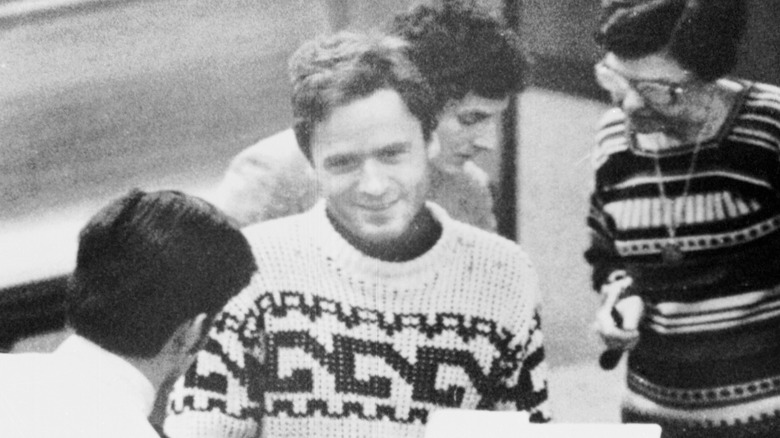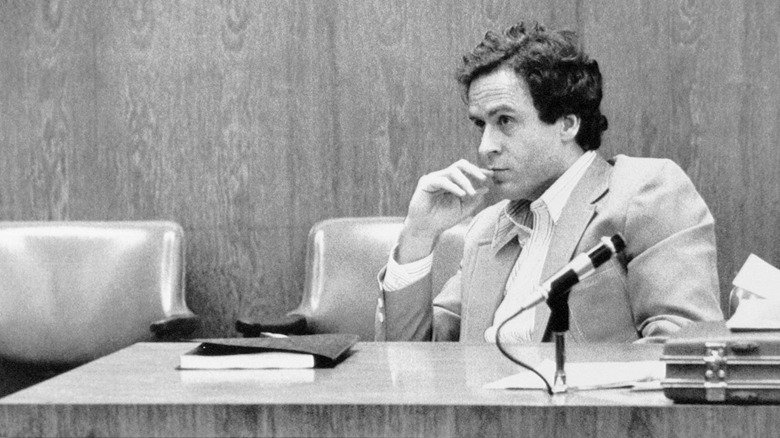How Was Ted Bundy Able To Get Away With So Many Murders?
Few serial killers have exerted such a hold on the American psyche as Ted Bundy, the seemingly charismatic, steely-eyed murderer who managed to avoid detection for years despite taking the lives of at least 30 women and girls between 1974 and 1978. After his arrest, Bundy faced three separate murder trials for these killings and was sentenced to death by the electric chair. He was executed in 1989. More recently, experts have suggested that his killing spree may have occurred over a longer period of time, and he may have been responsible for the deaths of over 100.
Bundy's crimes have remained famous in modern American history in part due to his persona. He had a clean-cut, suave look and an intelligent and expressive face that nevertheless exhibited no remorse for the crimes of which he was accused. Indeed, he fits the profile of coldly calculating serial killers as portrayed in popular culture. However, it could also be said that in many ways he set the template — especially in the way he managed to avoid detection, deceive everyone around him, and escape from the police's grasp time and time again. Today, his actions read like something straight out of a horror movie.
Killer looks
There have been more than 3,000 known serial killers operating in the United States over the course of the last two centuries, according to the University of Michigan. The vast majority of these are forgotten, local news stories that eventually faded from the country's collective memory. But others, like Ted Bundy, continue to fascinate true crime junkies decades after his execution.
Much of this has to do with his apparent good looks. For many, it seems inconceivable that someone as handsome and wholesome-looking as Bundy could be capable of such brutal crimes. But more important than what motivates those who consume Bundy-related content is the fact that the killer's looks initially made it easy to trust him, allowing him to trick both the police and his victims — whom he would also ensnare with deceptions, including pretending to be injured.
There is arguably something macabre about society's continuing fascination with a handsome serial killer who, for want of a better phrase, has become a true crime icon. But the fact is that Bundy's looks were a major part of his story — a superficial cloak of acceptability that ultimately made him incredibly dangerous to the women he encountered. He also changed his look frequently, using facial hair and different hairstyles to evade suspicion.
Education and respectability
William Shakespeare warned: "There's no art to find the mind's construction in the face." But it wasn't just Ted Bundy's facial features that reportedly gave the erroneous impression that he was benign, trustworthy, and harmless. He was also a college-educated law student who was respected by those he encountered in the course of his education. In addition, he was a member of the Republican Party and had good standing in the local community. As Biography notes, this meant that even after he started killing women in 1974, he avoided suspicion despite closely resembling a composite sketch made by police investigators.
Bundy's education also meant that he was in a position to act as his own defense when he was arrested on kidnapping charges in 1976 and eventually charged with murder the same year. The first trial was divisive, with Bundy winning many people over despite being convicted. But he was also granted access to a law library to prepare his defense, and he managed to escape from the building and go on the lam.
Flaws in the police system
It is tempting to characterize serial killers as being especially calculating and cunning, but it is also true that Ted Bundy was able to claim so many victims due to major flaws in the handling of the murders and of him as a suspect. Because the incident in the law library wasn't the only time he escaped custody. In a damning indictment of the police's handling of the suspected murder, three of Bundy's victims were killed in brutal and deadly attacks that came after he had been recaptured.
In 1977, the serial killer was arrested and jailed in Colorado but managed to escape again in December of that year by squeezing through a hole in his cell roof. On January 15, 1978, he struck again. He had fled to Tallahassee, Florida, and in the early hours of the morning he entered a women's sorority house on the campus of Florida State University. Carrying a wooden club, he ran riot attacking women at random. Among his four victims, two were killed and another two were left in a critical condition. Two weeks later, he attacked his final victim, a 12-year-old girl whom he raped and murdered. He was arrested in the following days after being pulled over for driving a stolen car.



